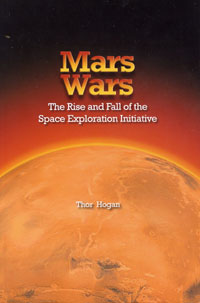Remembering the lessons of SEIby Taylor Dinerman
|
| The biggest failure in 1989 occurred when the White House failed to bring the Congress in at the very beginning of the process. |
Sadly the initiative that the administration hoped would insure US space leadership into the 21st century failed, due to economic pressure and political pettiness. The failure of SEI helped devastate important parts of the US space industry and contributed to the loss of US competitiveness and of US jobs. Some of the lessons from the failed initiative were applied in 2004 when George W. Bush launched the Vision for Space Exploration.
The biggest failure in 1989 occurred when the White House failed to bring the Congress in at the very beginning of the process. This should be obvious, but it amazing how often some administrations forget—or refuse—to deal with the legislative branch until it is too late. This is especially important for organizations like NASA, which perform research activities that could be regarded as luxuries and cut out during hard economic times.
In the late 1980s the US was perceived to be in the throes of a budget deficit crisis. By today’s standards it was pretty modest, but it did have a major influence of the willingness of Congress to fund any new programs. So the proposal would inevitably have been hard to sell to the American people.
The situation was made worse by the conflict between the White House’s National Space Council, led by Vice President Dan Quayle, and NASA Administrator Admiral Dick Truly, described by Hogan as a “Shuttle Hugger”. His record in getting the national space transportation system back into operation after the Challenger disaster showed him to be an outstanding NASA leader.
Truly was reluctant to go along with the plan. He did not believe that NASA could handle the job while at the same time building the space station, then known as Space Station Freedom and carrying out the agency’s usual menu of space and earth science. Nevertheless, after the president made his announcement he ordered Aaron Cohen at the Johnson Space Center (JSC) to write what became known as the “90 Day Study” on the program. It was this report that almost certainly killed whatever slim chance the initiative had of becoming reality.
Hogan points out that instead of taking the opportunity to reshape the management culture at NASA, “The only task was to define an aggressive program to meet President Bush’s new mandate.” Yet the agency’s priorities where not the same ones as the administration’s. They were protecting the shuttle and the station thus the study was shaped by the need to support the existing infrastructure.
This led to two major alternatives. One called for a human presence on the Moon by 2001 that would be used to develop the skills needed for human Mars exploration, with the first 600-day mission to Mars planned for 2018. The other had a much lower flight rate to the Moon (once a year) that eventually led to a permanent Mars outpost by 2027.
| Today, when the Constellation plan faces tough times the White House shows little sign, at least so far, of being willing to expend political capital to support the project. |
The total cost for the first alternative was estimated at $541 billion 1989 US dollars, while the other would cost $471 billion. These number shocked Congress and the public and opened the way for Bush’s political foes to pour their scorn on the plan. Then Senator Al Gore notably said, “before the President sets out on his mission to Mars, he should embark on a mission to reality by giving us some even faint indication where the $500 billion in going to come from.”
From 1989 until they left office in 1993 Bush and Quayle fought hard to keep the SEI alive. Repeatedly they saw every penny of money for their program stripped from the budget. It was a hard lesson seared into a generation of space advocates and NASA employees.
Today, when the Constellation plan faces tough times the White House shows little sign, at least so far, of being willing to expend political capital to support the project. If the US government is going to continue to lead the world’s space exploration efforts then it will have to spend the money needed to accomplish the goal in a reasonable time frame. Hogan’s book is a reminder of what happens when that political capital, and thus that funding, isn’t forthcoming.
